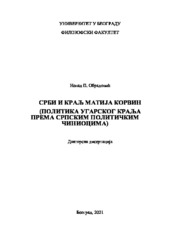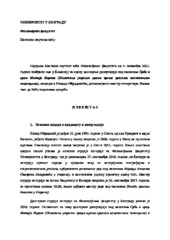Приказ основних података о дисертацији
Срби и краљ Матија Корвин: политика угарског краља према српским политичким чиниоцима
Serbs and king Matthias Corvinus: policy of the Hungarian king towards Serbian political actors
| dc.contributor.advisor | Ječmenica, Dejan | |
| dc.contributor.other | Mišić, Siniša | |
| dc.contributor.other | Šuica, Marko | |
| dc.contributor.other | Mitrović, Katarina | |
| dc.contributor.other | Stojkovski, Boris | |
| dc.creator | Obradović, Nenad | |
| dc.date.accessioned | 2022-09-06T14:11:07Z | |
| dc.date.available | 2022-09-06T14:11:07Z | |
| dc.date.issued | 2022-02-01 | |
| dc.identifier.uri | https://eteze.bg.ac.rs/application/showtheses?thesesId=8717 | |
| dc.identifier.uri | https://fedorabg.bg.ac.rs/fedora/get/o:26287/bdef:Content/download | |
| dc.identifier.uri | https://plus.cobiss.net/cobiss/sr/sr/bib/57491209 | |
| dc.identifier.uri | https://nardus.mpn.gov.rs/handle/123456789/20649 | |
| dc.description.abstract | Период владавине краља Матије Корвина (1458–1490) подудара се с временом османског напредовања на Балкану и нестанка српских средњовековних држава. Овај буран период је до сада био предмет истраживачке пажње већег броја југословенских, односно српских, као и мађарских и западноевропских историчара. Упркос томе, однос преостале елите српског народа према угарском владару и миграциони процеси нису у довољној мери расветљени. Значајним делом је то последица фрагментарности и раштрканости изворне грађе и недовољних предрадњи на издавању извора. Укључивањем до сада мање познатих и некоришћених дипломатичких и наративних извора показује се да је тај однос био сложен и вишеслојан, од кога је свака страна имала своја очекивања. Српске државе су пружале очајнички и жилав отпор, али се он показао недовољним у неравноправној борби са османским завојевачем. Ослонац су Српска деспотовина и Босна на крају свог постојања тражиле у суседној Угарској, упркос врло снажном неповерењу, која је и сама проживљавала бурне промене у својој политичкој и друштвеној структури. Малолетни краљ Матија Корвин морао се борити како би учврстио своју власт, тако да је настојао избећи сукоб са османским султаном чије је царство било спремније за рат. Са становништа прошлости српског народа гашење државне самосталности је доносило корените промене које су се исказивале у прекиду дотадашњег друштвеног развоја и бројним миграцијама унутар граница Османског царства и према Краљевини Угарској. Српско друштво постало је својим великим делом погранично са својим особеним системом вредности и менталитетом. Сеобе према суседној панонској краљевини за многе припаднике српског друштва, поготову за преостале представнике елите (чланови владарске породице Бранковић и део преостале властела), била је излаз из несигурног живота под османском влашћу. Пресељења су била потпомогнута чињеницом да су српски деспоти деценијама уназад одржавали чврсте везе са угарским краљевима. Српски владари су уласком у ред угарских барона стицали и немале земљопоседе на које су насељавали припаднике свог народа, а управу над њима су поверавали, између осталог, и српским чиновницима. Службеницима којима је било поверено управљање рудницима и ковницом новца, суђење и прикупљање дажбина упознавали су угарске обичаје и администрацију. Поседе су добијали и српски великаши који су тако стицали исукства о функционисању Краљевине Угарске, као и познанства међу припадницима властеоског сталежа ове државе. На другој страни угарски владар је трпео стални притисак од стране османске силе на својим јужним границама. Улед друштвених промена које су се одвијале до ступања краља Матије на власт, и током његове владавине, одбрамбене могућности су постале знатно неповољније за Угарску. Било је то условљено потискивањем угарске војске на своје јужне границе и нестанком система одбрамбених вазалних земаља. Недостатак финансијских средстава и заинтересованости сукобљених западноевропских држава натерале су краља Матију да одбрану своје државе организује ослањајући се на она средства која је имао. Корисног сваезника је видео у српским ратницима, до тада већ прекаљеним борцима против Османлија. Увиђајући да ће њихова борбена вештина, уз финансијску подршку у виду пореза насељених српских кметова, бити корисна, одлучио је да их плански насељава на јужним ободима своје државе. Настојећи да своје замисли учини стварношћу краљ Матија се користио и насилним методама одвлачења српског становништва и спаљивањем њихових места становања, али и финансијским олакшицама и толерантним ставом према њиховој вери. Угарски владар је, осим тога, као и османски султан, користио форме српске државности за решавање проблема унутрашње политике. Тако је настало Босанско краљевство, које је краљ Матија поверио угарском магнату Николи Илочком... | sr |
| dc.description.abstract | The period of the reign of King Matthias Corvinus (1458–1490) coincides with the time of the Ottoman advance in the Balkans and the disappearance of the Serbian medieval states. This turbulent period has so far been the subject of research topic by a large number of Yugoslav, i.e. Serbian, as well as Hungarian and Western European historians. Nevertheless, the attitude of the remaining elite of the Serbian people were not sufficiently aware of the Hungarian ruler and the migration processes. To a significant extent, this is a consequence of the fragmentation and scattering of the source material and insufficient pre-work on the publication of the sources. Including the hitherto lesser-known and unused diplomatic and narrative sources, it will be shown that this is a highly complex and multi-layered relation, due to the fact that each side had its own expectations. The Serbian states offered desperate and tenacious resistance, but it proved insufficient in the unequal fight with the Ottoman conqueror. At the end of their existence, the Serbian Despot-state and Bosnia sought support in neighboring Hungary, despite a very strong distrust, which itself experienced violent changes in its political and social structure. The young king Matthias Corvinus had to fight in order to consolidate his power, so he tried to avoid a conflict with the Ottoman sultan whose empire was more ready for war. From the point of view of the past of the Serbian people, the extinction of independent statehood brought radical changes which were manifested in the interruption of the previous social development and numerous migrations within the borders of the Ottoman Empire and towards the Kingdom of Hungary. Serbian society has largely become a border society with its own special value system and mentality. For many members of the Serbian society, especially for the remaining representatives of the elite (members of the Branković dynasty, part of the remaining nobles), the migration to the neighboring Pannonian kingdom was a way out of the uncertain life under Ottoman rule. The relocations were aided by the fact that Serbian despots had maintained strong ties with Hungarian kings for decades. By joining the ranks of the Hungarian barons, the Serbian rulers acquired considerable lands on which they settled members of their folk, and they entrusted the administration over them, among other things, to Serbian officials. Officials entrusted with the management of the mines and the mint, the trial and the collection of taxes introduced them to Hungarian customs and administration. The estates were also acquired by Serbian nobles, who thus gained experience in the functioning of the Kingdom of Hungary, as well as acquaintances among members of the ruling class of this state. On the other hand, the Hungarian ruler suffered constant pressure from the Ottoman power on its southern borders. Due to the social changes that took place until King Matthias came to power, and during his reign, defense opportunities became much more unfavorable for Hungary. This was conditioned by the pushing of the Hungarian army to its southern borders and the disappearance of the system of defensive vassal countries. The lack of financial resources and the interest of the conflicting Western European states forced King Matthias to organize the defense of his state, relying on the funds he had. He saw a useful ally in Serbian warriors, already hardened fighters against the Ottomans. Realizing that their fighting skills, with financial support in the form of taxes from inhabited Serbian serfs, would be useful, he decided to systematically settle them on the southern edges of his country. In an effort to make his ideas a reality, King Matthias used violent methods of abducting the Serb population and burning their places of residence, as well as financial relief and a tolerant attitude towards their faith. In addition, the Hungarian ruler, like the Ottoman sultan, used forms of Serbian statehood to solve the problems of internal politics. It is about the Bosnian Kingdom, which King Matthias entrusted to the Hungarian magnate Nicholas Újlaki... | en |
| dc.format | application/pdf | |
| dc.language | sr | |
| dc.publisher | Универзитет у Београду, Филозофски факултет | sr |
| dc.rights | openAccess | en |
| dc.rights.uri | https://creativecommons.org/licenses/by-nc-nd/4.0/ | |
| dc.source | Универзитет у Београду | sr |
| dc.subject | краљ Матија Корвин | sr |
| dc.subject | King Matthias Corvinus | en |
| dc.subject | Serbs | en |
| dc.subject | despot | en |
| dc.subject | Brankovićs | en |
| dc.subject | Vuk Grgurević | en |
| dc.subject | Jakšićs | en |
| dc.subject | Miloš Belmužević | en |
| dc.subject | hussars | en |
| dc.subject | nasadists | en |
| dc.subject | Serbian Orthodox Church | en |
| dc.subject | Serbian-Hungarian relations | en |
| dc.subject | migrations | en |
| dc.subject | Hungary | en |
| dc.subject | Ottoman Empire | en |
| dc.subject | Срби | sr |
| dc.subject | деспот | sr |
| dc.subject | Бранковићи | sr |
| dc.subject | Вук Гргуревић | sr |
| dc.subject | Јакшићи | sr |
| dc.subject | Милош Белмужевић | sr |
| dc.subject | Српска православна црква | sr |
| dc.subject | српско-угарски односи | sr |
| dc.subject | миграције | sr |
| dc.subject | Угарска | sr |
| dc.subject | Османско царство | sr |
| dc.title | Срби и краљ Матија Корвин: политика угарског краља према српским политичким чиниоцима | sr |
| dc.title.alternative | Serbs and king Matthias Corvinus: policy of the Hungarian king towards Serbian political actors | en |
| dc.type | doctoralThesis | |
| dc.rights.license | BY-NC-ND | |
| dc.identifier.fulltext | http://nardus.mpn.gov.rs/bitstream/id/145531/Disertacija_12423.pdf | |
| dc.identifier.fulltext | http://nardus.mpn.gov.rs/bitstream/id/146548/Izvestaj_Obardovic.pdf | |
| dc.identifier.rcub | https://hdl.handle.net/21.15107/rcub_nardus_20649 |



